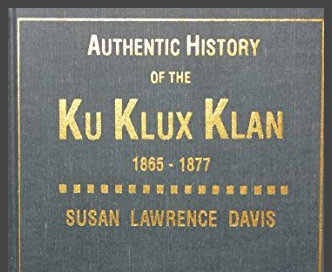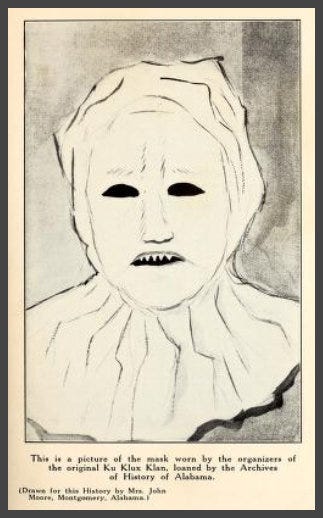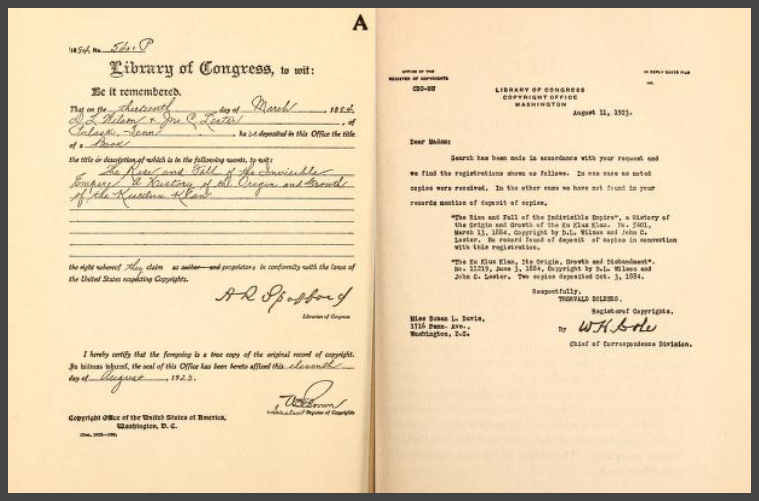The Rise of The Ku Klux Klan Part 4
The Reconstruction Era Part 4
Please note that any of my publications concerning anything that transpired during the War for Independence is purely in historical context relating the events leading up to the war, the Reconstruction Era, and beyond. I am in no way promoting racism, division, or anything other than what it is, which is the untold truths most Americans were never taught in school. This extensive research was done in libraries, State Archives, branches of the Sons of Confederate Veterans, actual documents, news articles, and other clippings found at my research sites, and including several rare books I purchased for my own Civil War collection.
Few nations in the last millennium have been so devasted by loss of life and property as the South was in 1865. Perhaps the Russians, Ukrainians, Poles, Serbians, and in turn, the German themselves in the Second World War endured such suffering. A Union general bragged that crows flying of the Shenandoah Valley of Virginia would need to pack their own lunches. The Union conquerors then proceeded with the reconstruction of the South by laying heavy taxes, confiscating much of their wealth in cotton and other goods, and forcing the sale of the land under taxation duress. They gave the right to vote to the blacks and took it away from Confederate veterans. They removed from Confederate veterans and their families all recourse to civil law and justice. They sent in swarms of Northern school teachers to teach their children to be ashamed of their fathers and their Southern heritage. They unleashed upon them a reign of terror with a constant threat of depredations and outrage at the hands of the Union League. Political opportunists from the North constantly promised blacks that the properties of whites would be confiscated and given to them if they voted Republican. Many of them also promised that Republican voting blacks would be given political and racial hegemony over the whites. The Union League regularly promised to hang blacks that did not vote Republican. Many blacks were, in fact, beaten or murdered for resisting the Union League political objectives. These circumstances made forceful underground resistance to Radical Reconstruction inevitable.
On Christmas Eve of 1865 was not a time of joy in Pulaski, Tennessee. So, six young Confederate veterans meeting in a law office decided to lift the spirits of the town by forming a club or a fraternity. Five of these six young men were Confederate officers during the war. Four of them were to become lawyers, one a circuit court clerk, and one a newspaper editor. Their first objective was to have some fun and lift the spirits of the town. To that end, they devised the rituals of a secret fraternal society with mysterious code words, elaborate titles, and costume disguises. Starting with the Greek word for circle, kuklos, they came up with the name, Ku Klux, and then added Klan because they were all of Scotch-Irish descent. Their costume regalia for themselves and their horses were made up of available bedsheets. The next week at dark they rode into town to introduce their new club, show off their mysterious regalia, and amuse and serenade sweethearts and family. It was a roaring success.
Their former slaves, however, thought that they had seen the ghosts of dead Confederate soldiers. During the following week, the agitation that had been stirred among their former slaves by political opportunists from the North was considerably reduced. The six young members of the Ku Klux Klan now realized they had a powerful psychological tool to curtail the violence and outrages being suffered by numerous Southern families. It would be a protective organization for beleaguered Southern whites as well as their black friends.
The original founders had strict character standards for membership. They wanted only men of principle and reliability. They placed a high emphasis on the ideals of chivalry, patriotism, respect for the Constitution and legitimate law. They sought to protect the weak and defenseless, especially Confederate widows and their children, and to relieve the injured and oppressed. This included relief from the oppressive and hatred cotton tax. Initiates pledged total abstinence from alcohol as long as they were members. They also pledged never to reveal that they were a member of the KKK or to reveal names of any other members. They were not anti-black, but they were white supremacists. This advocacy of white supremacy must be seen in a historical perspective to be fully understood today. Living under a black dominated society was an intolerable prospect to them, but this prospect was constantly threatened by federal authorities, the Union League, and carpetbagger demagogues appealing for black Republican votes.
White supremacy was not a political idea that was confined to the South. In fact, Southern white supremacy retained a paternalistic view of blacks, whereas the equally prevalent white supremacy of the North was simply anti-black. Most Northern states did not want blacks within their borders, and Indiana, Ohio, Illinois, and Oregon had strict laws to enforce this bias.
Lincoln’s attitude towards blacks was very typical of Northern whites, and he sometimes appealed to this sentiment in many of his political speeches. Lincoln was personally against slavery, but not at the cost of breaking up the country. Originally, before using emancipation as a military strategy, Lincoln favored a gradual, slave-owner compensated emancipation of African slaves, but favored also favored their removal to Central America, the Caribbean, or back to Africa. Lincoln’s thinking was very prevalent in the North. Before the war, Massachusetts was the only state in which blacks were allowed to be jurors. Even after the Radical Reconstruction disenfranchised whites and enfranchised blacks in the South in 1867, voters in Ohio, Michigan, Minnesota, and Kansas refused to extend the franchise to blacks.
The situation in Tennessee was aggravated by its Radical Republican Governor, William P. Brownlow. Brownlow forced through the puppet Legislature a bill disenfranchising Confederate veterans in June of 1865, a full twenty-one months before such a measure was taken in ten other states. Brownlow also provoked fear in Tennessee and the whole South with public pronouncements such as these:
“If I had the power, I would arm…every negro in the South, every devil in Hell, clothe them in the uniform of the Federal Army and then turn them loose on the rebels of the South and exterminate every man, woman and child, south of the Mason and Dixon line.”
Brownlow also said this to a New York audience:
“I would like to see negro troops under Ben Butler crowd every rebel into the Gulf of Mexico and drown them as the devil did the hogs in the Sea of Galilee.”
Brownlow disbanded the regular Tennessee Militia and replaced it with a force of black Union Army veterans and white bushwhackers to intimidate political opposition and resistance to his corrupt and tyrannical government. Because of this, Southern white supremacy was bolstered by constant threats of black supremacy and even wholesale white annihilation.
From Pulaski, Tennessee, the Klan then spread to nearby Athens, Alabama, the scene of Union pillaging during the war. Still under the guidance of its original founders, it continued to spread, and its dens began to take on the role of regulators protecting the people from abuse by the Union League and racketeering U.S. Treasury agents. In response to Union League murders and outrages, they also began to engage in retributive guerilla warfare. By May of 1867, their numbers and role had grown so large that the founders decided a leader of national prominence was needed. Meeting right under the nose of the Union Army at the Maxwell House Hotel in Nashville, they chose the famed Confederate calvary leader, Nathan Bedford Forrest of Memphis. The KKK then advances as a champion of the Southern people against the tyrannies of Reconstruction. But they would soon face a serious control problem. They did not have an enforceable patent on wearing white sheets.
The Invisible Empire: A Response to Federal Tyranny
It is of essential importance to understand that the Ku Klux Klan of the Reconstruction years of 1865 to 1877 has absolutely no connection to the various organizations calling themselves the Ku Klux Klan in the twentieth or present century.
It is likely that many of the original Klan members would be outraged by the indignities and atrocities committed by groups calling themselves the KKK beginning in or about 1915. The Klan of the Reconstruction Era rose in response to Federal tyranny against which the Southern people were allowed neither political nor legal recourse. Armed resistance was made inevitable and necessary for their children. The Klan can reasonably be credited with a significant role in breaking the back of the Reconstruction and with it the Radical Republican power and tyranny in the South. It could even be argued that they hastened the demise of the Radical Republican domination in the North. The major problem the Klan faced during Reconstruction was keeping its organization under control. There is also a public peril in any secret organization that attempts to administer justice. In addition, there was a problem of imitation by imprudent or unprincipled allies, and outright enemies such as the Union League. The KKK had no patent on white sheets and other disguises, and operating in disguise is a tactic anyone can imitate.
An enormous portion of the violence blamed on the KKK during Reconstruction was actually the work of the Union League. The League had found a way to disguise its violence and blame it on the KKK. The first two convictions under a Mississippi anti-Klan law in 1870 turned out to be two black Union League men who had been harassing a black Democrat. A U.S. Marshall in North Carolina also commented on the high number of Union League incidents using imitations of the KKK disguise. According to KKK agents stationed in Washington, this imitation strategy came out in a meeting of Radical Republican Congressmen in Washington. The Radical Republican governments in the South made a concentrated effort to report as many incidents of white violence against blacks and white Republicans as possible. They went much further than honest reporting to keep Congress and Republican voters in the North stirred up against reputed Southern misdeeds. There was much distortion and fabrication involved. In several instances race riots were incited by Radicals for their propaganda value.
In April of 1866, in Memphis there more than forty blacks killed in a race riot. This turned out to be a conflict between a garrison of black federal officers and Irish police of recent Northern importance. In the summer of 1866 in New Orleans, Radical Republicans who had lost control of the Louisiana government because of President Johnson’s amnesty to Confederate veterans planned an illegal convention reinstituting Radical government. Their objectives were to depose the Conservative government, insure passage of the 14th Amendment, enfranchise blacks and disenfranchise Confederate veterans. This coup d’état plot had an indirect assurance of support from Thaddeus Stevens himself in Washington. Two days before this convention, A.P. Dostie, a Northern dentist, agitating for their support, promised a gathering of two to three thousand, promised a gathering of two to three thousand blacks that:
“…a hundred thousand good and true Union white men” would “fight for and beside the black race against the hell-bound rebels.”
Dostie advised them to “come in your power” on the day of the coming convention. They did come, but as an angry and drunken mob that essentially overwhelmed and disrupted the convention. A riot ensued as New Orleans Police tried to disperse the mob. Thirty-four blacks were killed as well as Dr. Dostie. Several other whites were killed including one “disloyal” white. New Orleans Police reported their own casualties of forty-two dead or wounded. Such incidents as these were played up as Southern atrocities. News of Southern violence was of great political value in the North. Secretary Stanton had been warned of the danger of political violence by Federal Army commanders, but withheld notification from President Johnson and other Cabinet members. Control of the state reverted to Federal Army commanders until Radical power was imposed by the March 1867 Reconstruction Act.
According to a current internet source on the KKK, the Klan was responsible for killing over 1,500 Republicans during the 1868 elections. This distorted number comes from taking as truth the trumped-up numbers compiled by corrupt carpetbagger governments and flagrantly dishonest Radical politicians for the purpose of inflaming Northern voters and Congress against the South. This had dual purpose of perpetuating the corrupt and totalitarian carpetbagger governments in the South and winning elections in the North, while it covered up the depredations of the Union League. Within the Klan itself, however, there was a growing concern that violence by its own members and unrelated similar groups such as the White League, the White Brotherhood, and the Knights of the White Camellia, was escalating out of control.
One difficulty in studying about the Ku Klux Klan during the Reconstructive years is that the Klan members took very seriously their pledge never to reveal their own membership or the names of other members. It is generally acknowledged that General Nathan B. Forrest became the Grand Wizard or national director after a meeting held at the Maxwell House Hotel in Nashville May of 1867. Although never specifically admitting even his membership, his statements indicated such knowledge of and influence over the Klan that his leadership is reasonably certain.
In my opinion, the most authoritative source on KKK leadership was Susan Lawrence Davis, who published a history of the organization in 1924. Liberal and yet politically correct academics usually dismiss her book as being “discredited.” But she is alone through family connections, personally knew many of the KKK leaders in Pulaski, Tennessee, and Athens, Alabama. She remembers as a child speaking with General Forrest, when he visited her family’s home near Athens on “business.” In preparing for her book, she had had the unpublished manuscript of one of the Pulaski founders and interviewed several hundred men throughout the South that she knew to be KKK members. Furthermore, she appears to have been well educated and highly principled woman. Her “discredited” status owes to her Southern sympathies.
Forrest had been a Confederate Major General during the War and the South’s most famous and spectacular calvary leader. Robert E. Lee acknowledged him to be the best soldier on either side. Forrest was highly principled and a strict disciplinarian. He processed audacious courage and charismatic presence. He abstained from alcohol, gambling, and tobacco, and dismissed officers for immoral conduct with women. In respect to women, he was chivalrous to an Arthurian degree. In camp his tent became a small church on the Sabbath, although a certain confession of his Christian faith did not occur until after the war. It is highly unlikely that Forrest ever donned KKK regalia, attended a KKK rally, or participated in actual KKK operations. He and the Grand Dragons that he personally appointed over each state apparently acted something like political strategists and consultant directors. The KKK was an “Invisible Empire.” Forrest once told a reported that he could summon 40,000 men in Tennessee alone. The reporter concluded that the KKK was 500,000 strong in Southern states. The latter figure may be a wild exaggeration as other groups such as the Knights of the White Camellia were more numerous in some states than the Klan. During the war and undoubtedly afterwards, Forrest frequently used numerical deception of his strength to his advantage.
Of the ten men who are reputed to be the first Grand Dragons of their states were all Confederate officers and five were Confederate Generals. At least four became governors of states, U.S. Senators, or both. Because of very strict Klan secrecy on membership, many of these names are in dispute, but they included many illustrious names, such as John Brown Gordon of Georgia, Zebulon B. Vance of North Carolina, and Albert Pike of Arkansas.
The leadership of so many distinguished Confederate officers gave the KKK formidable capacity for guerilla tactics. Among them were men of equally formidable political abilities. Forrest’s demonstrated talents as a calvary leader for deceiving the enemy as to his numbers and location undoubtedly proved valuable to the KKK. The rise of the KKK very soon caused a considerable reduction in Union League atrocities and indignities. Meanwhile much of the work of the KKK was political organization and influence. Forrest’s talent for bluffing the enemy was both operational and for political advantage, but it also contributed to an unwanted credit for the violent action of others.
References:
Authentic History of the Ku Klux Klan, Susan Lawrence Davis, 1924. The link will take you to the digitized copy online.
Emancipating Slaves, Enslaving Free Men: A History of the American Civil War, Jeffery Rogers Hummel, 1996.











Thank you, Robert! 😊 Unfortunately, I lost a number of subscribers over it.
Thank you for this history sister. ✍🏼⚖️🕰️
Grace, peace, health, mercy and wisdom to you.